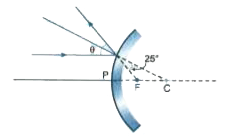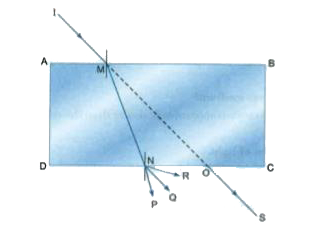Complete Solutions to VERY SHORT ANSEWR QUESTIONS of chapter LIGHT-REFLECTION AND REFRACTION of Class 10 book with complete answers and questions
| Class 10 | PHYSICS |
| Chapter | LIGHT-REFLECTION AND REFRACTION |
| VK GLOBAL PUBLICATION | VERY SHORT ANSEWR QUESTIONS |
| Number Of Questions | 61 |
| Academic Year | 2023-24 |
What is light ?
View SolutionWhat is a ray of light ?
View SolutionWhat is a beam of light ?
View SolutionName a communication device which uses light for its working.
View SolutionWhat is the angle of reflection when a ray of light falls normally on a plane mirror?
View SolutionWhat kind of image can be obtained on the screen?
View SolutionWhat type of image is formed:
(i) in a plane mirror, and (ii) on a cinema screen?
View SolutionName the type of mirror which always forms a virtual and diminished image.
View SolutionWhich mirror-convex or concave has larger field of view?
View SolutionIf an object is placed at the focus of a concave mirror, where is the image formed?
View SolutionWhat should be the position of the object when a concave mirror is to be used:
(i) as a shaving mirror?, and (ii) as a doctor's mirror?
View SolutionWhat sign (+ve or-ve) is given to the focal length of:
(a) a concave mirror?, and (b) a convex mirror?
View SolutionGive the cartesian sign convention for:
(a) height of a real image, and
(b) height of a virtual image.
View SolutionWhat is the significance of +ve sign of magnification?
View SolutionCan a plane mirror be called spherical mirror?
View SolutionA man standing in front of a spherical mirror, finds his image having a very small head, a fat body and legs of normal size. What type of mirrors are used in these three parts?
View SolutionDifferentiate between virtual image formed by a concave mirror and of a convex mirror.
View SolutionWhat is the magnification produced by a plane mirror?
View SolutionThe angle between an incident ray and the mirror is `40^@`.
(i) What is the angle of incidence?
(ii) What is the angle of reflection?
(iii) What is the total angle through which the ray of light turns?

View SolutionWhy does a convex mirror is said to have a virtual principal focus?
View SolutionWhat is the value of in the following ray diagram?

View SolutionExplain why a ray of light passing through the centre of curvature of a concave mirror gets reflected along the same path after reflection.
View SolutionDraw a ray diagram to show the path of the reflected ray corresponding to an incident ray of light parallel to the principal axis of a convex mirror and show the angle of incidence and angle of reflection on it.
View SolutionWhat is the nature of the image formed by a concave mirror if the magnification produced by the mirror is +3?
View SolutionBetween which two points of a concave mirror should an object be placed to obtain a magnification of - 3 ?
View SolutionThe outer surface of a hollow sphere of aluminium of radius 50 cm is to be used as a mirror. What will be the focal length of this mirror? Which type of spherical mirror will it provide?
View SolutionWhich property of concave mirror is utilised for using them as shaving mirrors?
View SolutionWhat is an optically rarer medium?
View SolutionWhat is an optically denser medium?
View SolutionDefine the term refraction of light.
View SolutionDefine the term angle of incidence.
View SolutionDefine the term angle of refraction.
View SolutionDefine the term refractive index of a medium in terms of speed of light.
View SolutionWhat is absolute refractive index?
View SolutionWhat is relative refractive index?
View SolutionWhat is the unit of refractive index?
View SolutionRefractive index of two material mediums X and Y are 1.3 and 1.5 respectively. In which of the two, the light would travel faster?
View SolutionWhat is the cause of refraction of light?
View SolutionWhat is the relationship between the refractive index of two media?
View SolutionIn which direction a ray of light bends when it goes from water to glass?
View SolutionIf refractive indices of water and alcohol are 1.33 and 1.36 respectively, which of the two is optically denser medium?
View SolutionIf a light ray IM is incident on the surface AB as shown, identify the correct emergent ray.

View SolutionWhy does a ray of light bend when it travels from one medium into another?
View SolutionWhat is a lens?
View SolutionName a point inside a lens such that a ray of light passing through it goes undeviated.
View SolutionName the phenomena on which the working of a lens is based.
View SolutionState two examples of phenomenon of refraction of light in everyday life situations.
View SolutionWhat is meant by power of a lens?
View SolutionGive the SI unit of power of lens. State whether the power of a converging lens is positive or negative.
View SolutionAspherical mirror and a lens have same focal length of - 20 cm. What type of mirror and lens are these?
View SolutionA small electric lamp is placed at the focus of a convex lens. What is the nature of beam of light produced by the lens?
View SolutionAn object is placed 80 cm from a converging lens of focal length 25 cm. What is the nature of the image?
View SolutionWhat is the power of a combination of lenses?
View SolutionState one advantage of using combination of lenses in optical instruments instead of a single lens.
View SolutionWhat is monochromatic light?
View SolutionHow does phenomenon of lateral inversion occurs?
View SolutionUnder what condition a lens becomes invisible when placed in a transparent liquid?
View SolutionDefine the term magnification.
View SolutionShow diagrammatically, how should two converging lenses be arranged so that a parallel beam becomes parallel after passing through two lenses.
View SolutionThe diagram below shows the refracted ray QR through a concave lens. Complete the diagram by drawing the corresponding incident ray.

View SolutionRedraw the given diagram and show the path of the refracted ray.

View Solution
VERY SHORT ANSEWR QUESTIONS questions and complete solutions for chapter LIGHT-REFLECTION AND REFRACTION of VK GLOBAL PUBLICATION PHYSICS (HINGLISH) of Class 10
All Exercises from VK GLOBAL PUBLICATION Class 10 PHYSICS LIGHT-REFLECTION AND REFRACTION
- HOTS (HIGHER ORDER THINKING SKILLS)
- LONG ANSWER QUESTIONS
- NCERT Exercises
- NCERT INTEXT QUESTIONS
- PROFICIENCY EXERCISE (Long Answer Questions)
- PROFICIENCY EXERCISE (Short Answer Questions-I)
- SHORT ANSEWR QUESTIONS-I
- SHORT ANSEWR QUESTIONS-II
- SOME IMPORTANT NUMERICALS
- SOME IMPORTANT NUMERICALS (FOR PRACTICE)
- VERY SHORT ANSEWR QUESTIONS